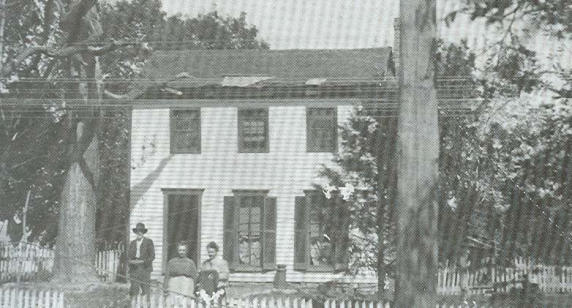
DOB: August 23, 1842
DOD: September 15, 1918
Age at Enlistment: 18
Date of Enlistment: May 9,1861
Place of Enlistment: Franklin, TN
Rank at Enlistment: Private
Rank at Discharge: Private
Casualty: None with the 1st Tennessee
Comments: George is the best source of information on the Williamson Grays. He wrote post war rosters, kept a diary, wrote
articles for the Confederate Veteran Magazine, and wrote several letters about his military experience. His daughter, Mary, donated
his records and writings to the Carter and Tennessee State Library and Archives. This collection has been very instrumental in
researching the company.
George was born and raised in the City of Franklin. His father was Justice of the Peace in town for many years. He had an older
brother named James “Blackhawk” and his nephew John Watson served in the Williamson Grays as well. George enlisted in the
Williamson Grays at their formation. On a roster dated September and October of 1861 George is listed as being sick in the hospital
at Hot Springs, VA. According to his diary he was present for the Cheat Mountain Campaign in September but there is no mention of
him getting sick around this time. In August 1862, George was left behind when the Army of Tennessee invaded Kentucky. He had
poison ivy and could not march but he was able to work as a Ward Master in a hospital run by a Dr. Leake. When he was released
from the hospital the 1st Tennessee was still in Kentucky so George hung around the 32nd Tennessee in Murfreesboro and even
joined them on an expedition to Nashville in November 1862. When the 1st Tennessee regiment finally arrived in Tullahoma a few
weeks later, George was able to rejoin them. On September 19, 1863, after the 1st Tennessee was pushed south of the Brotherton
Road, George states that he was part of a group of Infantry soldiers that helped Huggins Battery fire down the Alexander Bridge
Road. Soon the Battery needed to retire from the field but had lost too many horses. George and several other men from Company
D helped drag one of the cannons out by hand under fire and were able to save it. The Color Bearer of the 1st Tennessee was killed
in the fighting that day and George Nichols became color bearer of the 1st Tennessee on the second day of the battle and continued
in this capacity until December of that year.
In December 1863, George was a part of a group of 1st Tennessee soldiers that stole artillery horses and deserted to join Forrest’s
Cavalry. He joined the 18th Tennessee Cavalry Company F (later the 19th Tennessee Cavalry). On June, 1864, George’s unit was
opearting in McNairy and Hardin Counties in TN. George was detailed to go with a scouting party of about 7 men to locate the
position of Yankee Bushwackers in the area. The scouting party moved up the road until they started taking fire from a house where
the Federals were located. The scouting party returned fire and George dismounted his horse for the the fight. Just as he got off a
bullet struck his horse and then George had his right eye shot out as well as a wound to his left shoulder. After he fell to the ground a
Federal ran up and tried to take his pistol. William Moody, also a Williamson Gray that left the 1st Tennessee when George did, shot
the man and then had George thrown up on his horse and rode him to safety. George goes on to state that he was taken to a house
where he was cared for but no one thought he would make it. George survived his wounds and returned to service. On his pension
application he states he was captured in Mississippi and paroled in Memphis but he never took the Oath of Allegiance.
George held a few jobs after the war. According to the1870 Census he was a clerk in a grocery store, 1880 he is listed as a farmer,
and by the 1900 Census he is working as a Grocery Salesman. He was also the Tax Collector in Franklin for a number of years. He
married Alice McPhail on January 18, 1872 and the couple had two children. He built a house on Columbia Avenue on part of the
Franklin Battlefield and lived out the rest of his life there. He was very active in Veterans groups and was a member of the United
Confederate Veterans McEwen Bivouac. George passed away in Franklin in 1918 and is buried in Mount Hope Cemetery next to
John Watson in Section A. His coffin was draped with the original flag the Williamson Grays went to war with in 1861.
George was very fond of the camera and there are many photographs of him.

Mike Hoover is the web master and researcher for this page




Left: George Nichols photo taken in December 1861.
Right: George Nichols photo taken in Chattanooga in 1862 while he was in the hospital. You can see he started to let his hair
grow out. Both photos are at the Tennessee State Library and Archives.




Left: George Nichols photo taken just after the war. The damage to his eye is apparent. This tintype is mirrored and so the picture
makes it appear his left eye was damaged.
Right: George Nichols and family taken in the 1870’s or 80’s. George has turned his head in order to hide his bad eye. Both
photos are from the Tennessee State Library and Archives.


Left: George Nichols standing with the 1st Tennessee flag he carried at Chickamauga and Missionary Ridge.
Right: George Nichols and family standing in front of his house on Columbia Avenue in 1909 just after a tornado damaged his
house. Photo courtesy of the Williamson County Heritage Foundation.


Left: Top view of George’s tombstone in Mount Hope Cemetery.
Right: Side view of George’s tombstone in Mount Hope Cemetery.